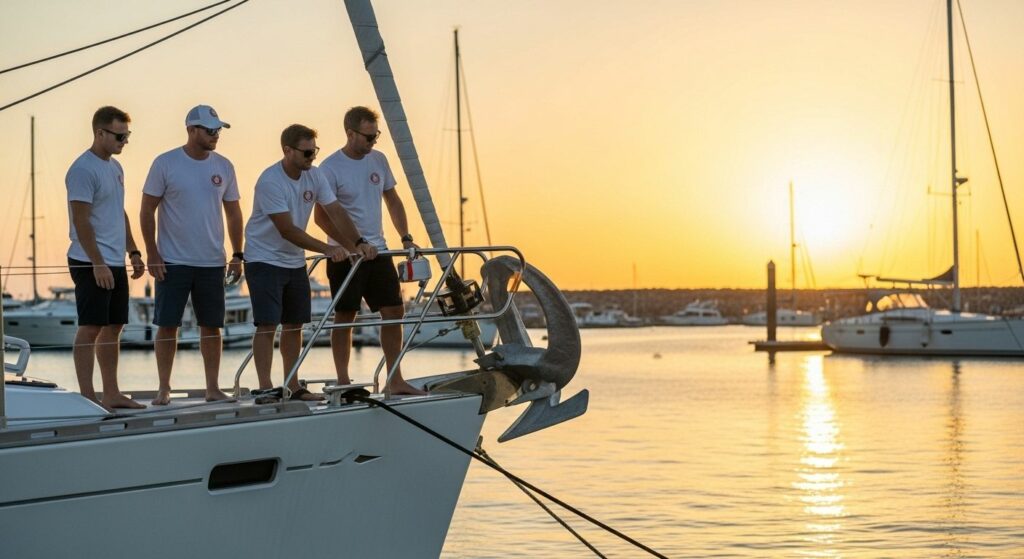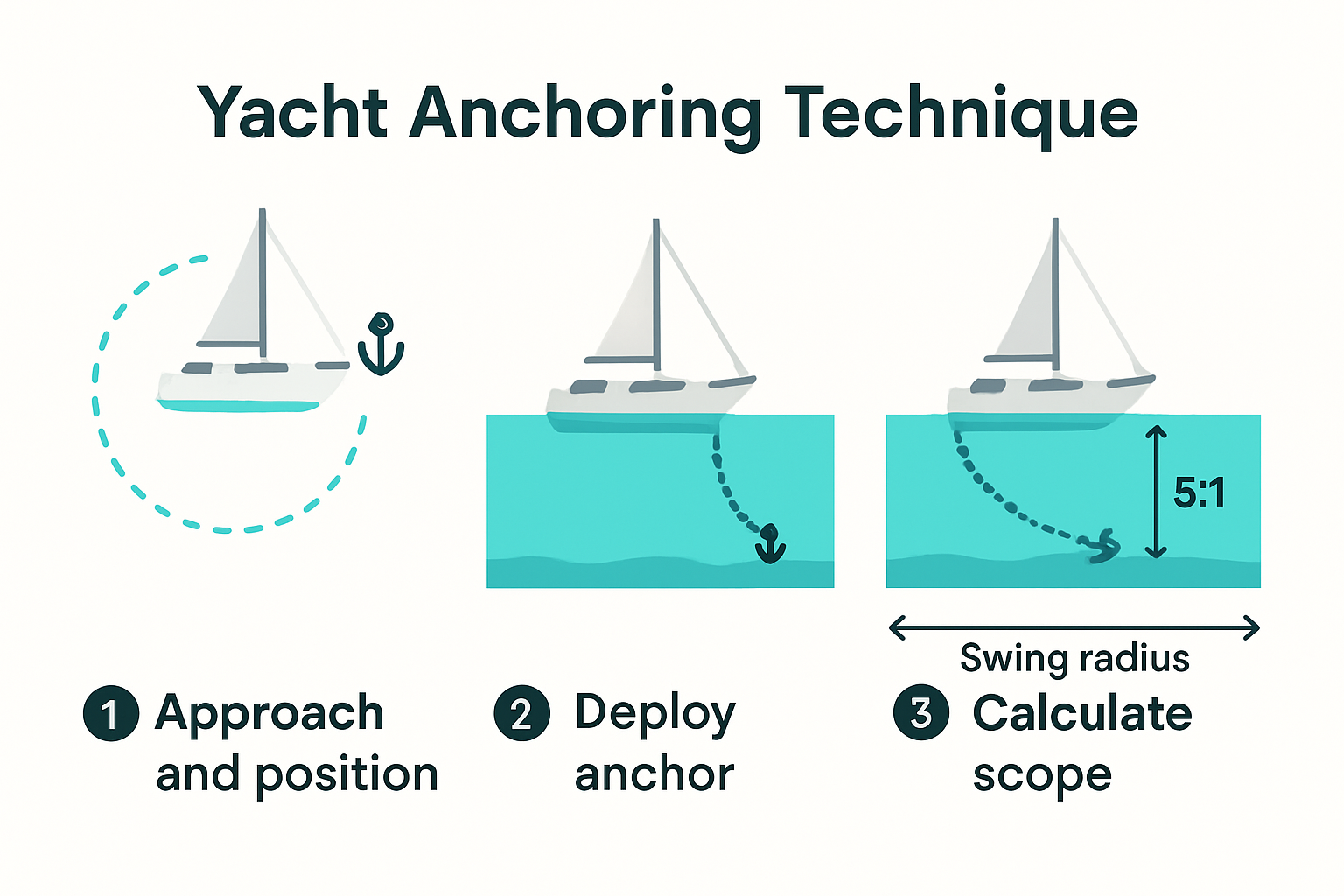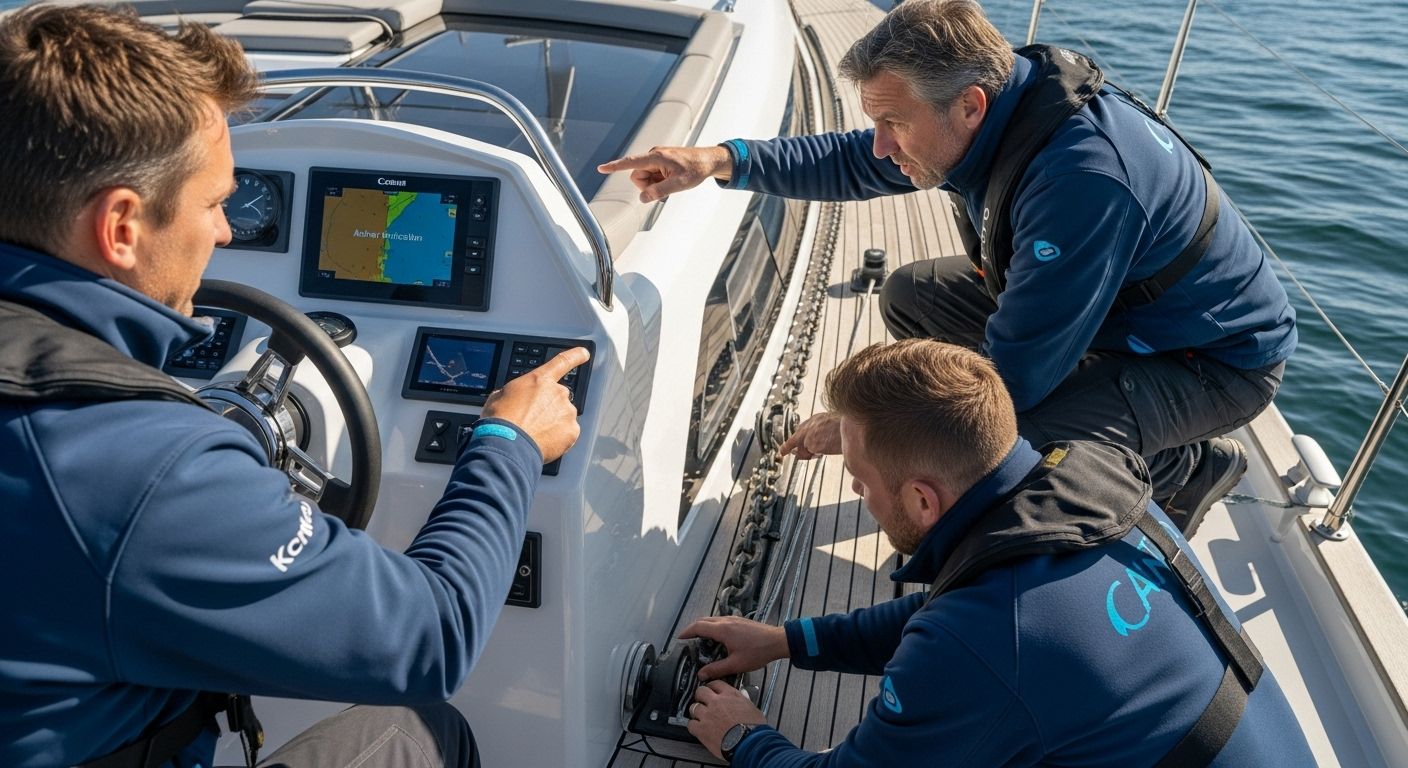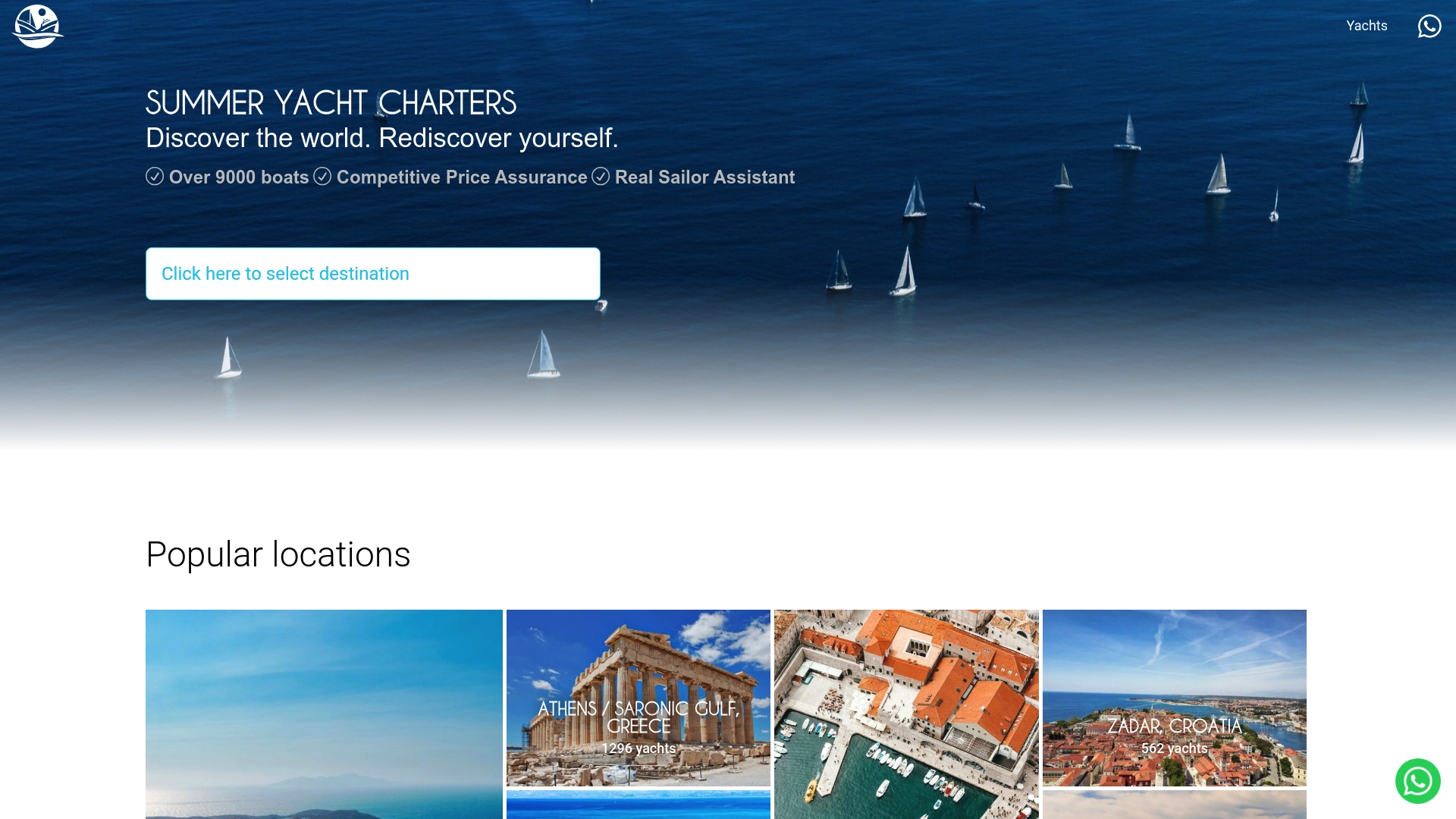How to Anchor a Yacht Safely: Step-by-Step Guide
Discover how to anchor a yacht safely in any location. Learn proven techniques, tips, and expert advice for secure and stress-free mooring.

Anchoring a yacht safely is one of the most crucial skills for any sailor, yet it is often surrounded by uncertainty and risk on the open water. Most people think lobbing an anchor overboard is enough. Not quite. Researchers have found that improper anchoring causes over 25 percent of all marine mishaps. The real secret is in the meticulous planning, the right equipment, and a deep understanding of the sea—so your safe mooring is no accident at all.
Table of Contents
- Essential Preparation Before Anchoring
- Choosing The Best Anchorage Spot
- Step-By-Step Yacht Anchoring Technique
- Common Challenges And Expert Solutions
Quick Summary
| Takeaway | Explanation |
|---|---|
| Conduct thorough location assessments | Evaluate wind direction and seabed conditions before anchoring to ensure safety. |
| Use proper anchoring equipment | Ensure all anchor components, such as chains and windlasses, are in good condition and appropriate for your vessel. |
| Calculate correct anchor scope | Employ a scope ratio of 7:1 for optimal holding power, which ensures your anchor remains firmly in place. |
| Regularly check anchor position | Monitor anchor status to detect any dragging or changes in position, adjusting as necessary to maintain safety. |
| Be prepared for equipment failure | Carry backup anchors and develop emergency response protocols to handle unexpected situations effectively. |
Essential Preparation Before Anchoring
Preparing to anchor a yacht requires meticulous planning and a comprehensive understanding of maritime conditions. Professional sailors know that successful anchoring begins long before the anchor touches the seabed. This critical phase involves strategic assessment, equipment verification, and thorough environmental evaluation.
Assessing Anchoring Location and Conditions
Before dropping anchor, experienced skippers conduct a comprehensive survey of the potential anchoring site. Wind direction and sea bottom composition are paramount considerations that directly impact anchoring safety. Nautical experts recommend thoroughly examining the seabed using depth sounders and marine charts to understand the underwater terrain.
The bottom composition significantly influences anchor holding power. Soft mud, sand, rocky surfaces, and coral areas require different anchoring techniques. Sandy bottoms typically provide excellent holding ground, while rocky or weedy areas can challenge anchor placement. Marine navigation guides suggest using specialized anchor types matched to specific marine environments to ensure maximum stability.
Skippers must also evaluate surrounding geographical features. Potential hazards include underwater obstructions, proximity to shorelines, marine traffic patterns, and potential swing radius. Understanding these factors prevents potential collisions and ensures the yacht remains securely positioned during anchoring.
Critical Equipment Preparation
Proper equipment preparation is non-negotiable for safe anchoring. Every yacht should have a well-maintained anchoring system comprising multiple components. Essential equipment includes:
- Primary anchor: Appropriately sized and weighted for your vessel
- Secondary anchor: Backup for unexpected situations
- Sufficient anchor chain: Recommended length typically 5-7 times the water depth
- Anchor windlass: Functional and regularly serviced
- Marine-grade shackles: Corrosion-resistant and rated for your vessel’s weight
Before departure, conduct a thorough equipment inspection. Check for wear, corrosion, or potential mechanical failures. Lubricate moving parts, verify shackle integrity, and ensure the anchor windlass operates smoothly. A proactive maintenance approach can prevent critical failures during anchoring.
Weather and Tide Considerations
Understanding meteorological and tidal conditions is crucial for safe anchoring. Wind speed, direction, potential storm systems, and tidal movements dramatically influence anchoring strategy. Professional sailors consistently monitor marine weather forecasts and tidal charts before selecting an anchoring location.
Tidal ranges can significantly impact anchor placement and holding power. During tide changes, vessels may experience substantial positional shifts. Calculating potential movement and selecting an anchoring spot that accommodates these changes helps prevent drifting or unexpected repositioning.
Additionally, consider creating a detailed anchoring plan that includes contingency measures. This involves identifying alternative anchoring locations, understanding local marine regulations, and preparing emergency communication protocols. Preparedness transforms potential challenges into manageable situations.
By investing time in comprehensive preparation, sailors significantly enhance their anchoring safety and overall maritime experience. Remember, successful anchoring is a blend of technical knowledge, environmental awareness, and meticulous planning.
Choosing the Best Anchorage Spot
Selecting an ideal anchorage spot represents a critical decision that directly impacts yacht safety, comfort, and overall sailing experience. Experienced sailors understand that the perfect anchoring location involves a nuanced evaluation of multiple environmental and geographical factors.
Evaluating Seabed Characteristics
To aid yacht owners in selecting the right spot for anchoring, the table below compares different seabed types and their suitability, as well as any special considerations mentioned in the article.
| Seabed Type | Holding Power | Suitability | Special Considerations |
|---|---|---|---|
| Sand | Excellent | Highly suitable | Allows anchor to dig in easily |
| Mud | Excellent | Highly suitable | Good penetration, stable |
| Rock | Poor to moderate | Challenging | Can damage anchor or slip |
| Coral | Poor | Not suitable | Risks anchor damage, ecological harm |
| Weed/Grass | Variable | Can be difficult | May prevent proper anchor set |
The foundation of selecting an excellent anchorage begins with understanding seabed composition. The U.S. Coast Guard Navigation Center emphasizes the critical importance of identifying a bottom surface that provides reliable anchor holding ground. Different seabed types offer varying levels of anchor grip and stability.
Sandy and muddy bottoms are generally considered optimal for anchoring, providing excellent anchor penetration and holding power. These surfaces allow anchors to dig in securely, creating a stable mooring environment. Rocky or coral-laden seabeds can pose significant challenges, potentially compromising anchor effectiveness and risking damage to marine ecosystems.
Modern sailors leverage advanced marine navigation technologies to assess seabed conditions. Electronic charts, depth sounders, and satellite imagery offer detailed underwater terrain insights. Professional skippers recommend conducting a thorough visual and electronic survey before committing to an anchoring spot, ensuring maximum safety and minimal environmental impact.
Analyzing Environmental Protection and Shelter
Beyond seabed characteristics, effective anchorage selection requires comprehensive environmental assessment. Wind protection and wave exposure are paramount considerations that directly influence anchoring comfort and vessel stability. Ideal anchoring locations offer natural geographical barriers such as headlands, islands, or coastal formations that mitigate strong winds and turbulent water conditions.
Skippers must evaluate potential swing radius, ensuring sufficient space for the yacht to rotate without risking collision with shorelines, underwater obstacles, or other vessels. Maritime navigation experts recommend maintaining a minimum swing radius of at least three to four times the water depth, accounting for potential wind and current variations.
Additional environmental factors include proximity to marine traffic lanes, underwater topographical features, and potential hazard zones. Experienced sailors develop a holistic understanding of the surrounding maritime landscape, anticipating potential challenges and selecting anchorages that offer both security and comfort.
Regulatory and Safety Considerations
Responsible anchoring extends beyond physical location selection. Sailors must navigate complex maritime regulations and local restrictions that govern anchoring practices. Navigational authorities often designate specific zones for vessel mooring, with restrictions based on marine protected areas, environmental conservation efforts, and local maritime traffic management.
Before anchoring, sailors should:
- Consult local maritime charts and navigational guides
- Verify anchoring permissions in specific zones
- Understand potential environmental protection regulations
- Check for seasonal restrictions or marine conservation guidelines
Technological advancements have simplified regulatory compliance. Mobile applications and digital maritime resources provide real-time information about anchoring regulations, marine conditions, and potential restrictions. Proactive research and digital tool utilization can significantly enhance anchoring safety and legal compliance.
Choosing the best anchorage spot represents a sophisticated blend of technical knowledge, environmental understanding, and strategic decision-making. By meticulously evaluating seabed characteristics, environmental protection, and regulatory frameworks, sailors can create a safe, comfortable, and responsible maritime experience.
Step-by-Step Yacht Anchoring Technique
Mastering the art of yacht anchoring requires precision, practice, and a systematic approach. Professional sailors understand that successful anchoring is not just about dropping an anchor, but executing a carefully choreographed sequence of maritime manoeuvres.

Approach and Positioning
The American Sailing Association recommends a methodical approach to anchoring that begins well before the anchor touches the water. Approach the chosen location slowly and deliberately, positioning the yacht head to wind or current. This strategic positioning provides maximum control and allows for a controlled descent of the anchor.
Professional skippers typically follow a precise entry protocol. Reduce speed to minimal forward momentum, ensuring the vessel maintains directional stability. Wind direction and current strength become critical factors in determining the optimal approach angle. Experienced sailors constantly assess environmental conditions, making real-time adjustments to ensure a smooth anchoring process.
Communication becomes paramount during this phase. If sailing with a crew, establish clear hand signals or verbal commands to coordinate anchor deployment. The bow person should have a clear line of sight and be prepared to manage anchor release and rode management.
Anchor Deployment and Setting
BoatUS Foundation emphasizes the critical importance of proper anchor line and gear selection. Professional sailors typically use a combination of nylon three-strand line and chain, which provides both shock absorption and weighted stability. The anchor deployment technique involves a precise sequence of actions:
- Approach the anchoring spot with controlled, slow forward movement
- Stop the vessel completely
- Lower the anchor slowly and deliberately over the bow
- Allow the anchor to descend to the seabed under its own weight
- Begin paying out anchor line while gently reversing the yacht
Calculating the correct scope is crucial for secure anchoring. Boat-Ed guidelines recommend a typical scope ratio of 7:1 – meaning seven feet of anchor line for every foot of water depth. This ratio ensures maximum anchor holding power and reduces the risk of dragging.
Anchor Verification and Secure Positioning
After initial deployment, sailors must verify the anchor’s secure positioning. This involves a series of diagnostic techniques to confirm effective ground tackle. Use visual reference points on the shoreline to check if the vessel is maintaining position. Modern advanced navigation tools can assist in confirming precise positioning.

Professional skippers recommend performing a drag check by briefly applying reverse engine power. This test ensures the anchor has sufficiently penetrated the seabed and will hold the vessel securely. Watch for any unexpected movement or drift that might indicate an improperly set anchor.
Continuous monitoring remains essential. Environmental conditions can change rapidly, potentially compromising anchor stability. Experienced sailors periodically reassess their anchoring situation, checking wind shifts, tide changes, and potential proximity to other vessels or underwater obstacles.
Successful yacht anchoring is a blend of technical skill, environmental awareness, and calm decision-making. By following a systematic approach and maintaining situational awareness, sailors can ensure a safe and secure mooring experience.
Common Challenges and Expert Solutions
Anchoring a yacht presents numerous potential challenges that can test even the most experienced sailors. Understanding these complex scenarios and developing strategic solutions is crucial for maintaining vessel safety and preventing potentially dangerous maritime situations.
Anchor Dragging and Slippage
The U.S. Coast Guard Auxiliary identifies anchor dragging as one of the most critical challenges sailors encounter. Anchor slippage can occur due to multiple factors, including inappropriate bottom conditions, insufficient scope, or sudden environmental changes.
Professional mariners recommend several diagnostic and preventative strategies. First, conduct a comprehensive drag check by applying moderate reverse engine power after initial anchor deployment. This technique helps verify the anchor’s penetration and holding capacity. If the vessel moves unexpectedly during this test, it signals the need for immediate repositioning or re-anchoring.
Key indicators of potential anchor dragging include:
- Unexpected vessel movement
- Changing distance from original reference points
- Unusual tension in anchor rode
- Sudden shifts in vessel orientation
Modern technological solutions have emerged to address this challenge. Wireless anchor monitoring systems now provide real-time alerts about anchor position, allowing sailors to detect potential slippage before it becomes a critical safety issue.
Environmental Interference and Complex Seabed Conditions
Navigating diverse marine environments requires adaptive anchoring techniques. Different seabed compositions—ranging from soft mud to rocky terrain—present unique challenges for secure anchoring. Maritime navigation experts emphasize the importance of understanding local marine topography and selecting appropriate anchoring equipment.
Rocky or coral-laden bottoms can compromise anchor effectiveness, potentially causing equipment damage or incomplete anchor setting. Sailors must be prepared with multiple anchor types and understand their specific performance characteristics. Lightweight lunch hook anchors work effectively in sandy conditions, while heavier plow or Bruce anchors provide better grip in challenging terrains.
Additional environmental considerations include:
- Tidal range and current strength
- Wind speed and direction variations
- Underwater geological features
- Potential marine traffic interference
Equipment Failure and Emergency Protocols
The following table outlines common yacht anchoring challenges alongside expert-recommended solutions, helping sailors quickly identify and address potential risks.
| Challenge | Typical Causes | Recommended Solutions |
|---|---|---|
| Anchor dragging/slippage | Poor bottom, insufficient scope, shifts | Perform drag check, increase scope, reposition |
| Environmental interference/complex seabed | Rocky/coral seabed, currents, tides | Use appropriate anchor type, assess local conditions |
| Equipment failure | Wear, corrosion, mechanical issues | Carry backup anchors, inspect and maintain equipment |
Professional sailors understand that equipment can fail unexpectedly, necessitating robust backup strategies. Anchor system redundancy becomes critical in managing potential maritime emergencies. This involves carrying multiple anchor types, ensuring comprehensive maintenance, and developing clear emergency protocols.
Critical equipment preparation includes:
- Carrying at least two different anchor types
- Maintaining spare shackles and anchor lines
- Regularly inspecting anchor windlass mechanisms
- Developing crew emergency anchoring procedures
Maintaining a calm, systematic approach during unexpected challenges is paramount. Experienced skippers train their crews to handle equipment failures through regular drills and comprehensive maritime safety training. Advanced navigation resources can provide additional guidance on developing robust emergency response strategies.
Successful yacht anchoring transcends technical knowledge—it represents a dynamic interaction between human skill, technological preparation, and environmental understanding. By anticipating potential challenges and developing comprehensive solutions, sailors can transform potential maritime complications into manageable, safe experiences.
Frequently Asked Questions
What are the essential preparations before anchoring a yacht?
Before anchoring, it’s crucial to assess the location, prepare the necessary equipment, and understand the weather and tide conditions. This includes checking wind direction, seabed characteristics, and ensuring all anchoring equipment is in good condition.
How do I choose the best anchorage spot for my yacht?
Look for areas with ideal seabed conditions such as sandy or muddy bottoms for better holding power. Also, consider wind protection, wave exposure, and the proximity to other vessels and potential hazards while selecting your spot.
What is the correct scope ratio for anchor deployment?
A general guideline for anchor scope is a ratio of 7:1—this means using seven feet of anchor line for every foot of water depth. This ratio helps ensure maximum holding power for the anchor.
What should I do if my anchor is dragging or slipping?
If you notice your anchor dragging, perform a drag check by briefly using reverse engine power. If it drags, reposition or reset your anchor. Regularly monitor for changes in position or unexpected movements to ensure safety.
Anchor With Confidence Across the Mediterranean
When it comes to anchoring your yacht securely, guidance only gets you so far. The real peace of mind comes from knowing you have access to expertly maintained boats, tailored local advice, and support around the clock. At Summer Yacht Charters, we make sure your safe anchoring experiences in the Mediterranean are never left to chance. Whether you dream of calm coves in the Ionian Islands or hidden bays of the Aegean, our curated fleet and planning support allow you to put every tip from our guide into effortless practice.

Set sail with advanced navigation tools, first-class vessels, and a customer care team that truly understands the art of anchoring. Secure your ideal charter at Summer Yacht Charters now so you can focus on enjoying the journey while we handle the logistics and local expertise. Book your Mediterranean adventure today and experience the comfort of anchoring like a true professional.
Recommended
- What Is a Yacht Charter? Essential Guide for 2025 – Summer Yacht Charters
- Yachting with Friends: Top Experiences & Expert Tips 2025 – Summer Yacht Charters
- Plan the Perfect Yachting Journey: A Step-by-Step Guide – Summer Yacht Charters
- Sailing Holidays for Couples: Discover Romantic Destinations – Summer Yacht Charters